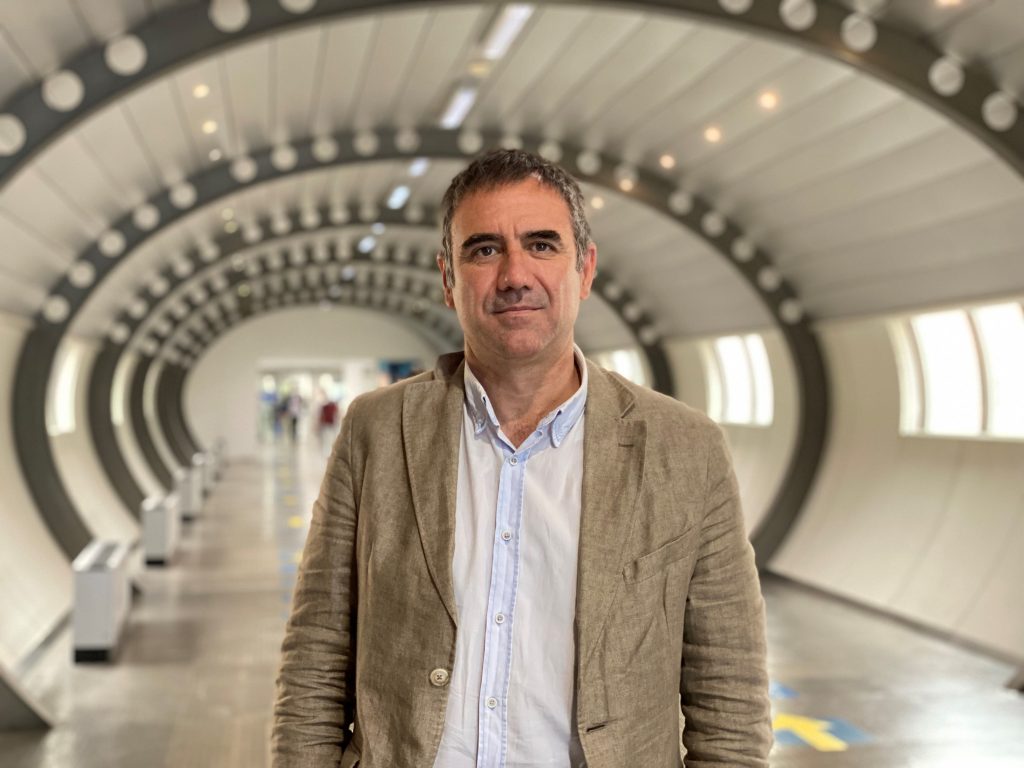Elkarrizketa- Miguel de los Toyos, Eusko Jaurlaritzako Lurralde Plangintzaren eta Hiri Agendaren sailburuordea
«Opengela beste hiri-ingurune batzuetarako erreferentzia izatea eta beste ekimen batzuen inspirazioa izatea espero dut»

Miguel de los Toyos, Eusko Jaurlaritzako Lurralde Plangintzaren eta Hiri Agendaren sailburuordea
Miguel de los Toyos Eusko Jaurlaritzako Lurralde Plangintzaren eta Hiri Agendaren sailburuordea bihurtu zen joan den martxoan, Eibarko alkate kargua, 2008tik, utzi ondoren. Beraz, Opengela proiektuari buruz duen ezagutza osoa da, bai udalaren ikuspegitik, bai egungo erantzukizunetik.
Elkarrizketa honetan, Eusko Jaurlaritzako sailak koordinatutako proiektuaren inguruan duen ikuspuntua ematen du. Proiektuak auzo-bulegoak ezartzen ditu hiria berroneratzeko prozesuei ekiteko, eta Europako Batzordearen Horizon 2020 programak finantzatzen du. Otxarkoaga (Bilbon) eta Txonta (Eibar) pilotuak dira, eta dagoeneko hasi da eredua beste leku batzuetan errepikatzeko prozesua.
Opengela proiektua gertutik ezagutzen duzu. Erakundeen arteko eta auzokoen arteko koordinazio-maila handia eskatzen du. Hasi eta bi urtera, nola kalifikatzen duzu proiektua?
Proiektuak hiru oinarri ditu, eta ezin da bat bera ere alde batera utzi: Eusko Jaurlaritza, sustatzaile gisa; udalak, konpromiso serio eta konbentzitua behar dutenak; eta auzo-komunitateak. Horrek esan nahi du aldez aurreko lana, informazioa ematekoa eta konpromisoa erakustekoa, luzea eta progresiboa dela. Beraz, ikusi ahal dena, hau da, erreformak, proiektuaren azken fasean egiten dira, baina horrek ez du esan nahi aurretik landu ez denik. Denbora asko eman behar da azkenean proiektuak aurrera egin dezan eta oinarrietan indarra izan dezan. Une honetan, oinarri horiek finkatuta daude eta orain eraikina nola hazten den ikusiko dugu.
Europako Itun Berdearen barruan, ‘Berriztatze olatuaren’ aldeko apustu handia egin da Europan, pandemiaren ondoren ekonomia bultzatzeko eragile nagusietako bat den aldetik. Nola egokitzen da Opengela proiektua testuinguru horretan?
Opengela, hasiera batean, bat dator nazioarteko, Europako, nazioko eta Euskal Herriko politika publiko guztiekin. 2015ean, Nazio Batuek 17 Garapen Jasangarriko Helburuak ezarri zituzten, eta horietan 11.a hiri jasangarriak dira. Opengela GJH horren gauzatzearen adibide praktikoa da. Orain hiru trantsizio aipatzen dira eta guztiak Opengelan ematen dira. Ekologikoa: Opengelak eraginkortasun energetikoa eta 2050erako deskarbonizazioa bilatzen ditu, hau da, irisgarritasuna. Trantsizio digitalean, energia-komunitateak, kontsumoen digitalizazioa eta mugikortasun elektrikoa sortzen dira. Eta trantsizio soziala eta demografikoa. Hiria berroneratzeko proiektua da, eta ingurunea ez ezik (eraikinak, kaleak, plazak) pertsonak ere kontuan hartzen ditu. Prestakuntza, enplegua eta pertsona ahulen babesa lantzen ditu. Opengelak dioenez, Itun Berdearekin bat dator hasieratik, ituna bera existitu aurretik.
Hiria berroneratzeko proiektu ugari daude Espainian eta Europan. Zerk bereizten du Opengela?
Proiektu honek ikuspegi holistikoa du, zeharkakoa. Hiri-ingurunea identifikatu da, ez Jaurlaritzak bakarrik, baita udalek ere. Eta alderdi soziala funtsezkoa da, auzo ahuletan jarduten delako.
Europako proiektu honen arrakasta eredua Bilbotik eta Eibartik haratago egiteko aukeraren araberakoa izango da. Badira beste udalerri batzuk eredu bera aplikatzeko lehen urratsak ematen ari direnak. Nola doa prozesu hori?
Proiektuarekin bat egin zuten bi udalerriei, Bilbori eta Eibarri, beste bi gehitu zaizkie: Lasarte eta Durango. Eta, laster, Pasaia ere partaide izango da. Lan asko egin da, eta orain aurrera egiten dugu, hiri-berroneratze moduan emaitzak lortzeko. Horretan ari gara enbrioi-fasean. Aldi berean, Bizkaiko beste lau udal sartzen ari gara Opengelan: Portugalete, Trapagaran, Abanto-Zierbena eta Santurtzi. Beren inguruneetan jarduteko moduari buruzko hausnarketetan, hiri-berroneratzea proiektu estrategiko gisa identifikatu dute. Gauza bera gertatzen da Arabako beste eskualde batean, Aiaraldean. Horrek erakusten du hiri-berroneratze integralaren interesa. Laster Europatik funts gehigarriak jasoko ditugu eta, hiria berroneratzeko proiektuak bultzatzeko, 70 udalerri baino gehiagoren eta 110 ekimen baino gehiagoren interes estrategikoa jaso dugu. Oraindik garapen-fasean dauden bi udalerritako esperientzia pilotu batetik, Opengelak berez erakarri du antzeko diagnostikoa duten beste udalerri batzuen interesa. Arrakasta horrek Europako proiektu honetara aurkeztean aukera ona hartu genuela erakusten du. Aurrerapauso bat eman genuen, eta beste batzuk urrats egokia zela berretsi dute.
Zure ustez, zein da proiektuari ekiteko zailtasun nagusia?
Udaletik bizi izan dut proiektu honen zatirik handiena, alkate gisa. Opengelaren konplexutasun nagusia ideiak bateratzea eta proiektuan parte hartzen duten komunitate eta pertsona guztiei haiekin bizi-kalitatea nola hobetuko duten ikusaraztea da. Eusko Jaurlaritzak lehen azalpen-lana egiten du udaletan, eta, gero, udalek egiten dute lan bera auzokoekin. Prozesu geldoa da, progresiboa. 16 etxebizitzako komunitate bati igogailua jartzeko erabakia hartzea luzea bada, pentsa 200 etxebizitzako komunitate bat dagoela inguru kaltebera batean. Ados jarri behar dira. Pedagogia eta aukera bistaratzea, agian konplexua dena baina, zalantzarik gabe, ezinbestekoa dena.
Funtsezkoa da hiri-berroneratzeko prozesuak auzotarren partehartzearekin egitea. Zuk kalean bertan entzun dituzu pertsonen kezkak. Nola antzeman dela uste duzu proiektua?
Pertsonen artean desberdintasunak ohikoak dira. Komunitate batzuek kezka bat dute eta beren beharrak antzeman dituzte: igogailua, fatxada konpontzea… Kasu horretan, errazagoa da hurbiltzea, eta laguntzaile bihurtzen zara. Beste komunitate batzuek ez dute behar hori antzeman, eta nolabaiteko eszeptizismoa dute. Hasierako konfiantza falta, auzoko proiektuak aurrera ateratzen direla ikusten duten heinean, eraikinak arrakastaz eraberritzen direla ikusten dute, eta horrek hurbilen bizi direnen egunerokotasunean duen eragin positiboa errazago gainditzen da.
Opengelaren proiekzio europarra ukaezina da. Zergatik aztertu beharko lukete Europar Batasuneko beste leku batzuk Euskadin hiri-berroneratzeari dagokionez garatzen ari den prozesua?
Denok ikasi behar dugu guztiengandik. Beste leku batzuetan arreta jarri dugu. Baina, nire ustez, hemen irakasteko ekimenak baditugu. Ziurrenik, denei ez die balioko, herrialde eta udalerri bakoitzak bere izaera duelako. Baina egon daitezke balio dieten aldagaiak. Opengelak duen birtualtasunik handiena, alde batetik, 2050erako lortu nahi ditugun hiriekin eta urte horretara iritsi arte egin nahi dugun bidearekin lerrokatuta dagoela da. Eta, bestetik, proiektuaren zeharkakotasuna. Intelektualki oso ondo arntolatuta dago. Ez dugu guk esaten, baizik eta beste agenteek, Hiri Agendaren Ministeriotik eta bertaratzen garen nazioko eta nazioarteko foroetan. Orain auzo ahuletara eramaten ari gara, eta errealitate bat bihurtzen ari da. Espero dut beste hiri-ingurune batzuetarako erreferentzia izatea eta beste ekimen batzuk inspiratzea.


Egitasmo honek Europar Batasunaren Horizon 2020 ikerketa eta berrikuntza programaren dirulaguntza jaso du, zbk. 846707 dirulaguntza-hitzarmenaren arabera
Otxar Opengela
Helbidea: Pau Casals hiribidea, 16 (Otxarkoaga, Bilbo).
Telefono zenbakia: 946 85 19 32
Posta elektronikoa: otxaropengela@vvmm.bilbao.eu
Txonta Opengela
Helbidea: Txonta kalea, 3, beheko solairua (Eibar)
Telefono zenbakia: 688 77 97 37
Posta elektronikoa: txontabulegoa@eibar.eus
Copyright@2019 | Eskubide erreserbatu guztiak | Lege oharra | ![]()
![]()
Copyright@2019 | Eskubide erreserbatu guztiak | Lege oharra | ![]()
![]()


